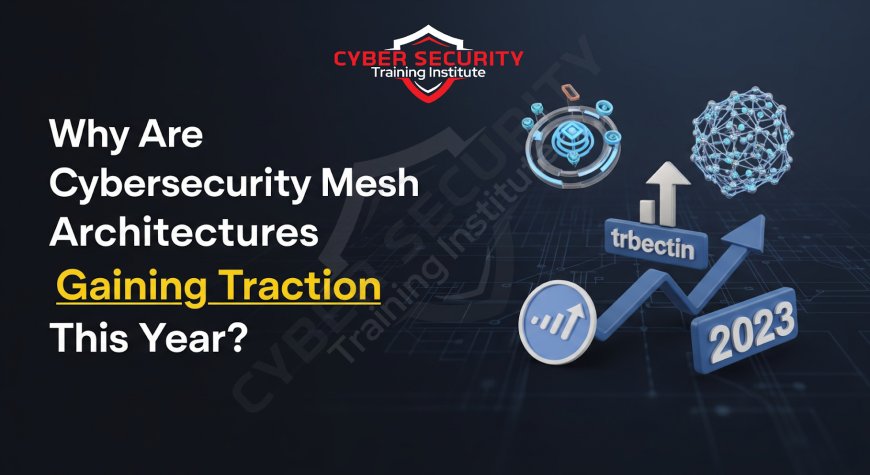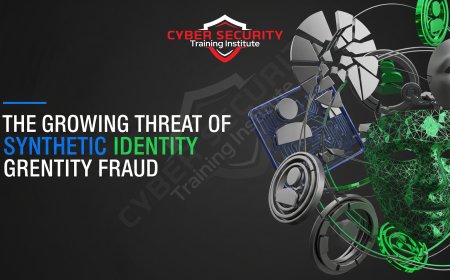Why Are Cybersecurity Mesh Architectures Gaining Traction This Year?
The traditional "castle-and-moat" security model is broken. Discover why Cybersecurity Mesh Architecture (CSMA) is the essential architectural strategy gaining traction in 2025 to secure the modern, distributed enterprise. This article, written from Pune, India in July 2025, explains why CSMA is moving from a buzzword to a practical necessity. It contrasts the failed perimeter-based model with the mesh's distributed, identity-centric approach. The piece details the four foundational pillars of a CSMA—Identity Fabric, Security Analytics, Centralized Policy, and Distributed Enforcement—and explores the implementation challenges and the critical role of AI. It provides a strategic roadmap for organizations looking to build a more resilient and scalable security posture for the perimeter-less era.

Table of Contents
- Introduction
- The Castle-and-Moat vs. The Secure City
- The Driving Forces Behind CSMA Adoption in 2025
- The Core Principles of a Cybersecurity Mesh
- The Four Foundational Pillars of a Cybersecurity Mesh Architecture
- The Implementation Challenges of a CSMA
- The Role of AI and Automation Within the Mesh
- A Roadmap to Implementing a Cybersecurity Mesh
- Conclusion
- FAQ
Introduction
For years, the dominant model for enterprise security has been the "castle-and-moat"—a strong, heavily fortified perimeter designed to keep threats out. But as recent events have shown with devastating clarity, that model is broken. The perimeter has dissolved. Our data is in the cloud, our users are everywhere, and AI-driven threats can bypass perimeter defenses with ease. In response to this new reality, a new architectural approach is rapidly gaining traction across Indian and global enterprises this year. It's called the Cybersecurity Mesh Architecture (CSMA), and it represents a fundamental rethinking of how we implement security. So, why are cybersecurity mesh architectures gaining traction this year?
The Castle-and-Moat vs. The Secure City
The traditional castle-and-moat model assumed everything inside the network perimeter was "trusted." This created a hard, crunchy shell but a soft, chewy center. Once an attacker breached the perimeter, they could often move laterally with little resistance. A Cybersecurity Mesh Architecture, by contrast, is like designing security for a modern, sprawling city. There is no single wall around the city. Instead, security is distributed and applied to individual assets. Every important building (application, database, device) has its own security checkpoint, and access is granted based on the verified identity of the person trying to enter, not just because they are already "inside the city."
The Driving Forces Behind CSMA Adoption in 2025
The shift to CSMA is not an academic exercise; it is a direct response to the immense pressures facing security leaders today:
- The Distributed Enterprise: With the permanence of remote work and the migration to multi-cloud environments, there is no longer a centralized location where users and data reside.
- The Explosion of Identities: Security now needs to manage and secure a vast number of identities—not just human users, but IoT devices, applications, and AI bots, all of which need access to resources.
- Failure of Perimeter-Centric Tools: Sophisticated AI-powered threats can easily bypass traditional firewalls and VPNs, making perimeter-only defense an ineffective strategy.
- Tool Sprawl and Lack of Integration: Most organizations have dozens of disconnected security tools. CSMA provides a framework for making these tools work together in a cohesive, interoperable ecosystem.
The Core Principles of a Cybersecurity Mesh
CSMA is not a single product you can buy, but rather a strategic architectural approach built on four key principles:
- Identity as the New Perimeter: Security controls are decoupled from the network and attached directly to the identity of a person or thing seeking access.
- Centralized Policy Management: Security policies (e.g., who can access what, from where, and under what conditions) are managed from a central point of authority.
- Distributed Policy Enforcement: While policies are managed centrally, they are enforced at the point of access—closest to the resource being protected.
- Interoperability and Analytics: The mesh is built on a foundation of interoperable tools that can share data and security signals, which are then fed into a central analytics engine to detect threats.
The Four Foundational Pillars of a Cybersecurity Mesh Architecture
A practical CSMA implementation is built on four interconnected technology pillars that work in concert:
| Pillar | Core Function | Key Technologies Involved | How It Improves Security |
|---|---|---|---|
| 1. Identity Fabric | Provides a comprehensive, real-time view of all identities (human and machine) and their access rights across the enterprise. | Identity & Access Management (IAM), Privileged Access Management (PAM), Directory Services, Decentralized Identity. | Creates a single, authoritative source of truth for identity, which is the foundation for all security decisions. |
| 2. Security Analytics & Intelligence | Collects and analyzes security signals from across the mesh to detect threats, predict attacks, and assess risk. | SIEM, SOAR, UEBA, AI/ML Threat Detection Platforms, Threat Intelligence Feeds. | Enables real-time threat detection and response across the distributed environment, moving beyond siloed alerts. |
| 3. Centralized Policy Management | Translates business and security requirements into consistent policies that can be applied across the entire IT ecosystem. | Policy as Code (PaC) platforms, Cloud Security Posture Management (CSPM). | Ensures consistent security posture and simplifies governance, regardless of where assets are located (on-prem, cloud, edge). |
| 4. Distributed Enforcement | Enforces the centrally managed policies at the point of access, closest to the resource. | Zero Trust Network Access (ZTNA), Web Application Firewalls (WAF), API Gateways, Endpoint Protection (EPP/EDR). | Delivers granular, context-aware security that protects individual resources, effectively creating micro-perimeters. |
The Implementation Challenges of a CSMA
While the benefits are clear, transitioning to a CSMA is a significant undertaking with several hurdles:
- Integration Complexity: Getting security tools from different vendors to be truly interoperable and share data seamlessly is a major technical challenge.
- Legacy Systems: Applying mesh principles to older, monolithic legacy applications that were not designed with modern identity standards can be difficult and costly.
- *
Policy Management Overhead:
- While centralized, managing granular access policies for thousands of users and devices can become highly complex if not planned properly. *
Cultural Shift:
- The biggest hurdle is often cultural. It requires moving the entire IT and security organization away from a deeply ingrained, network-centric view of the world to an identity-centric one.
The Role of AI and Automation Within the Mesh
A Cybersecurity Mesh Architecture cannot function at scale without extensive AI and automation. They are the engine that powers the mesh:
- AI in Analytics: AI and machine learning are essential for the "Security Analytics and Intelligence" pillar, analyzing trillions of signals to detect complex threats and predict breaches.
- Automation in Policy Enforcement: Automation, driven by SOAR platforms, is used to translate AI-driven insights into real-time enforcement actions, such as automatically revoking access for a user whose account shows signs of compromise.
- AI-Driven Policy Adaptation: Advanced CSMA implementations use AI to dynamically adjust access policies based on real-time risk, for example, requiring a user to re-authenticate if they exhibit unusual behavior.
A Roadmap to Implementing a Cybersecurity Mesh
For organizations in India and elsewhere looking to adopt CSMA, a phased, pragmatic approach is crucial:
- 1. Start with Identity: The first and most critical step is to consolidate and strengthen your Identity and Access Management (IAM) practices. You cannot build a mesh without a solid identity fabric.
- 2. Adopt a Zero-Trust Philosophy: Begin implementing Zero Trust principles. Start with a specific use case, like replacing your legacy VPN with a Zero Trust Network Access (ZTNA) solution for remote workers.
- 3. Prioritize Interoperability: When procuring new security tools, make interoperability via open standards (like OpenID Connect, SAML, SCIM) a mandatory requirement.
- 4. Consolidate and Integrate: Look for opportunities to consolidate security functions into integrated platforms to reduce tool sprawl and improve data sharing.
Conclusion
The Cybersecurity Mesh Architecture is more than just a buzzword in 2025; it is the logical and necessary evolution of security architecture. It directly addresses the reality of the modern, distributed, and perimeter-less enterprise. By making security more composable, scalable, and identity-centric, CSMA provides a coherent strategy for protecting assets no matter where they are located. For organizations navigating the complex threat landscape of today, adopting a mesh approach is no longer an option—it is essential for survival and resilience.
FAQ
What is a Cybersecurity Mesh Architecture (CSMA)?
CSMA is a strategic architectural approach to security that creates a distributed, identity-centric control plane. Instead of a single perimeter, it builds a "mesh" of individual perimeters around each device, user, or application.
Is CSMA the same as Zero Trust?
No, but they are closely related. Zero Trust is a security philosophy ("never trust, always verify"). CSMA is the architectural framework that helps you implement a Zero Trust strategy across a distributed enterprise.
Why is CSMA gaining popularity in 2025?
The widespread adoption of cloud computing, permanent remote work, and the proliferation of IoT devices have made the traditional perimeter obsolete. CSMA is designed specifically for this modern, distributed reality.
Is CSMA a product I can buy?
No, it's not a single product. It's an architecture you build by integrating various security tools (like IAM, ZTNA, EDR) in a way that allows them to interoperate and enforce a centralized policy.
What is the "Identity Fabric" pillar?
The Identity Fabric is the foundation of the mesh. It's a consolidated layer that manages all identities (human and machine) and their access rights, providing a single source of truth for making security decisions.
How does a mesh improve on the "castle-and-moat" model?
The old model had a strong exterior but a weak interior. The mesh model protects each asset individually, so even if an attacker gets "inside" the network, their ability to move laterally and access other resources is severely restricted.
What are the biggest challenges to implementing a CSMA?
The main challenges are integrating disparate security tools from different vendors, extending security to legacy systems, and overcoming the cultural inertia of perimeter-based security thinking.
What role does AI play in a CSMA?
AI is crucial. It powers the analytics engine that detects threats across the mesh, helps automate policy enforcement, and can dynamically adjust access controls based on real-time risk.
What is Zero Trust Network Access (ZTNA)?
ZTNA is a key technology for implementing a mesh. It provides secure access to applications based on a user's verified identity and context, regardless of their location, effectively replacing traditional VPNs.
How does a CSMA handle IoT security?
By creating a micro-perimeter around each IoT device or group of devices. The mesh can enforce strict policies on what an IoT device is allowed to communicate with, limiting the damage if it gets compromised.
What does "distributed enforcement" mean?
It means that while security policy is managed centrally, the actual blocking or allowing of access happens as close to the resource as possible (e.g., at the API gateway, on the endpoint device itself).
Can a small business implement a CSMA?
Yes, though on a smaller scale. A small business can start by implementing core principles like strong IAM, MFA, and a ZTNA solution, often through integrated cloud security platforms.
What is Policy as Code (PaC)?
PaC is the practice of managing security and access policies using code, which allows for automation, version control, and consistent application of policies across a complex environment, a key enabler for CSMA.
How does a mesh architecture help with compliance?
By centralizing policy management and providing detailed logs from across the distributed environment, a CSMA makes it much easier to demonstrate and enforce compliance with regulations like GDPR or HIPAA.
What is the first step my company should take towards CSMA?
The first and most critical step is to get your identity management in order. A strong Identity and Access Management (IAM) program is the non-negotiable foundation of any successful mesh.
What is Cloud Security Posture Management (CSPM)?
CSPM tools are important for a mesh as they continuously monitor cloud environments for misconfigurations and policy violations, feeding this information into the central analytics and policy engine.
How does a mesh help against ransomware?
By limiting lateral movement. If a single endpoint is infected with ransomware, the mesh architecture makes it much harder for the malware to spread across the network to other servers or backups.
Does CSMA eliminate the need for firewalls?
No, but it changes their role. Next-generation firewalls still play a part in segmenting the network and inspecting traffic, but they are just one of many distributed enforcement points, not the sole perimeter defense.
What are the top vendors for CSMA technologies?
There is no single "CSMA vendor." Leaders in different pillars include Microsoft (Identity, EDR), Zscaler (ZTNA), Palo Alto Networks (Firewall, SASE), CrowdStrike (EDR), and Okta (IAM).
Is the Cybersecurity Mesh just a Gartner hype term?
While Gartner popularized the term, the underlying architectural principles are a real and necessary response to the evolution of IT environments and the threat landscape. It's a practical framework for solving modern security challenges.
What's Your Reaction?
 Like
0
Like
0
 Dislike
0
Dislike
0
 Love
0
Love
0
 Funny
0
Funny
0
 Angry
0
Angry
0
 Sad
0
Sad
0
 Wow
0
Wow
0















